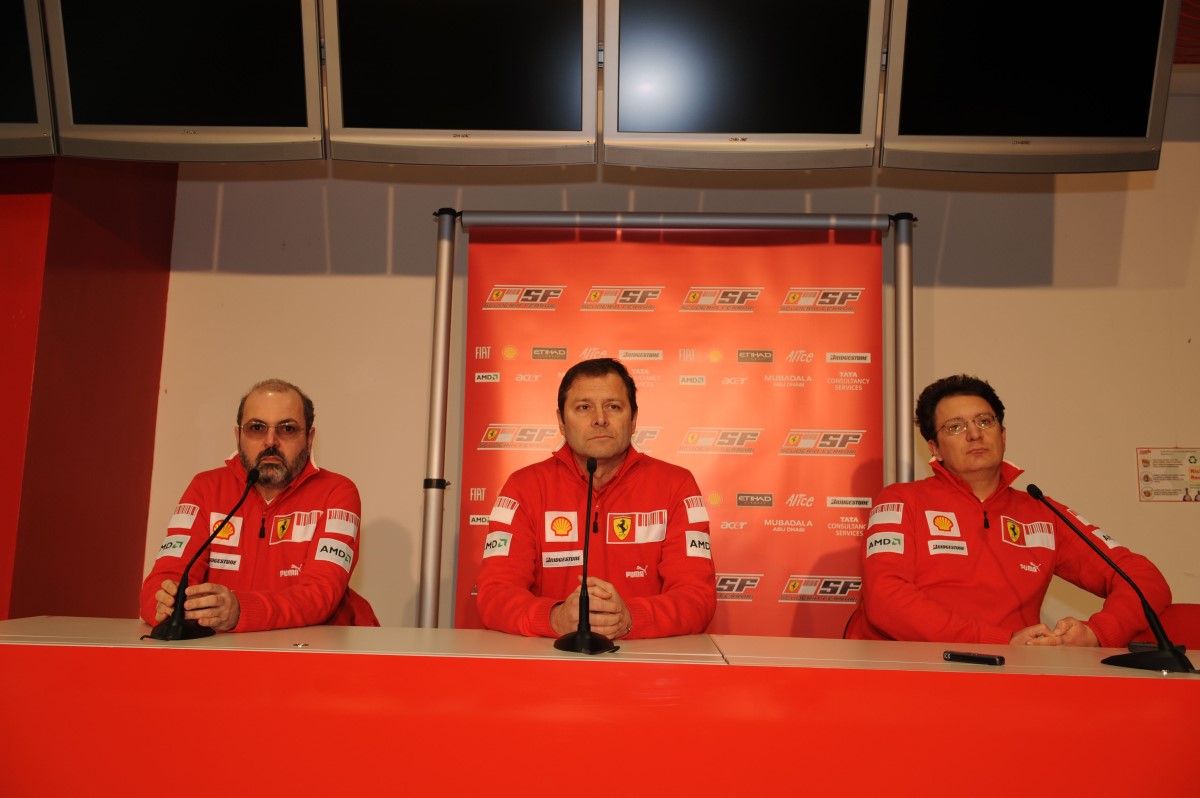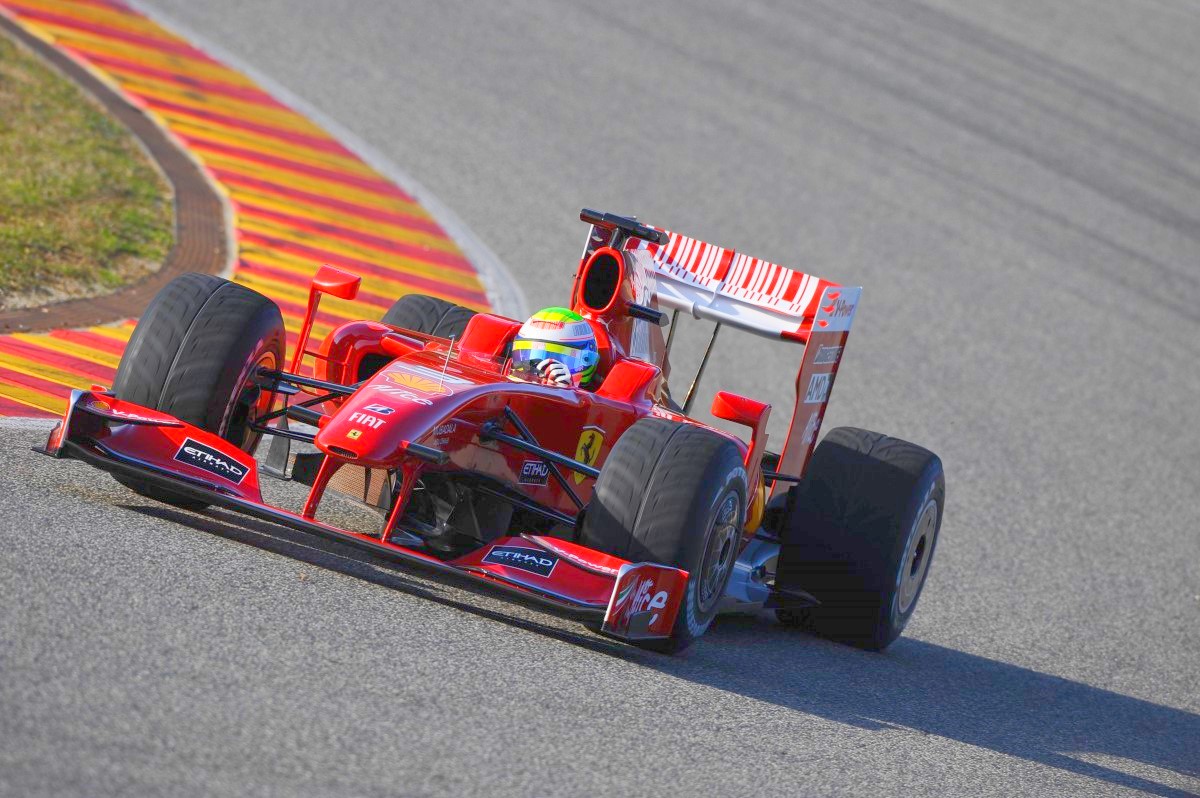F60 to be heavily revised for Melbourne
Ferrari's technical team has admitted that there is still a lot to do before they would consider it ready for action at the opening round of the 2009 season in Melbourne.
 |
| Gilles Simon, Aldo Costa, Nikolas Tombazis |
Speaking after Felipe Massa had given the F60 a brief shakedown at Mugello, Gilles Simon, Nikolas Tombazis and Aldo Costa conceded that the radical overhaul of the F1 rulebook for the coming season had left them with numerous angles to consider both in the design and development of the machine.
"Last year, we were fighting for the championship until the last race and concentrated a lot on the car's development," Costa explained, "Today we presented a complete car, which refers also to the level of the engine speed, and fitted with KERS.
"Although we had very short time, I want to congratulate everybody – Gilles, Nikolas and everybody at Maranello.
We can have eight aerodynamic tests this year, which means eight days where we can test as far as this issue is concerned."
Tombazis confirmed that work would continue on the new car right up until Melbourne, although the speed at which changes could be made may be limited by expected staff cuts – a problem facing all ten teams.
 |
| Ferrari F60 on track |
"The F60 will be very much overhauled for the first GP," he noted, "The rules have been changed recently, so we have to rethink our working methods and the programs, but this has to be done gradually, without rushing things. We have to evolve the team's structure. Also because this year will be dominated by the team which will be able to develop the fastest, we want to resolve all the issues as far as the mechanics and the reliability are concerned [before the season starts].
"Obviously the KERS' 'nuisance' is remarkable – we're talking about more than 30kg of weight – but we've done a lot of developmental work to insert the system and compensate for it.
"We also want to maximize the aerodynamic development, so I can confirm that, visibly, the car will be really different at the first race. Many rules, as far as the aerodynamics are concerned, are completely new, so the speed of development will be the main issue. Whoever knows how to develop faster will be better than the others. We can work on the development in the Fridays at every GP and, before the season, there's still some good margin. And, if we're ahead at the first race, it means that we can keep our cool."
With no in-season testing, teams will be forced to use the opening day of each grand prix to develop their cars for specific circuits, as well as working on any future ideas. However, the Scuderia is not ruling out the possibility of being able to rework the car if its proves less than successful.
"We have to deal with a shorter coverage," Costa confirmed, "On Fridays, we have to think about the development for the specific races, considering that there won't be any tests on the circuits, and then we also have to move on with the development for the championship – all of this with a limited mileage. It's much more limited. However, we're used to thinking that we can still work on a technical level; so as far as we concerned it's all possible.
"The work at the tests will be more important than in the previous years. We've also several facilities to test sub-components and complete groups, and that's where we'll do most of the work. The race track is, and remains, the final test. We'll work a lot before the start of the championship, just like last year; but this time we'll concentrate our work on one car in five test sessions."
"The KERS is a very complex system, which we haven't developed on the track yet," Simon said, "There's still lots of work to do, but we've lowered the impact of the system on the car to a minimum."
While KERS will keep the engine team busy, however, Simon is happier with the way other areas under his jurisdiction have worked out.
"After one year, the MES [McLaren-designed engine management system] is much more developed and stable, and it also seems more balanced than a year ago," he commented, "Also, as of 2009, the engine speed is limited to 18,000rpm and every driver can use up to eight engines over the 17 GPs of this championship. Therefore, the distance target for each unit is now around 2500km."
"The car's general construction philosophy could lead to the benefits we've seen in the past," Costa concluded, "We try to keep these benefits and develop the parts where we were less strong.
"There have been some radical changes this year and, today, under the light of limitations, the performance will not be higher. The limitations don't allow us to reach the previous performance levels, but I can confirm that the methods improve from year to year, and it happened last winter."
Q&A
After the meeting with Stefano Domenicali the press conference of the Scuderia's technicians – Gilles Simon, Nikolas Tombazis and Aldo Costa – was held at the Mugello circuit.
First of all the journalists wanted to know more about the regulations concerning the engines: there will be eight engines for every driver over the whole season. But will they be all the same?
Gilles Simon said: "As of 2009 the engine speed is limited to 18,000 rpm and every driver can use up to eight engines over the 17 GPs of this Championship. Therefore distance target for each unit is now around 2,500 kilometers."
The F60 is a single-seater which is very different to the previous ones, due to the 2009 regulations. Will Ferrari make more use of the test stands?
Costa: "The work at the test stands will be more important than in the previous years. We've several facilities to test sub-components and complete groups; that's where we'll do most of the work. The race track is and remains the final test. We'll work a lot before the start of the Championship, just like last year; but this time we'll concentrate our work on one car in five test sessions. During the season we'll have the Fridays to set up the cars for the circuit and for development."
This year the single-seater is completely different from the ones in the past. Are you happy with the result or did you have to compromise?
Costa: "Last year we were fighting for the Championship until the last race and we were concentrated a lot on the car's development. Today we presented a complete car, which refers also to the level of the engine speed, fitted with KERS; although we had very short time. I want to congratulate everybody: Gilles, Nikolas and everybody at Maranello. We managed to be the first having a crash test and we have several homologated chassis. We tried as much as possible to cover the time gap between the developments, which have been done on the car at the end of last year.
Do you think that this year, considering the changes, it won't be possible to redo the car during the season to make up an eventual disadvantage at the start?
Costa: "We're used to thinking that we can still work on a technical level; so as far as we concerned it's possible."
Tombazis: "Many rules, as far as the aerodynamics are concerned, are completely new. The speed of development will be the main issue. Whoever knows how to develop faster will be better than the others. We can work on the development in the Fridays at every GP. Before the season there's still some good margin. And if we're ahead at the first race, it means that we can keep our cool."
What was the Team's reaction in terms of cost cutting?
Costa: "The rules have been changed recently; we have to rethink our working methods and the programs; this has to be done gradually, without rushing things; we have to evolve the Team's structure.
How will your development program look like now? How many aerodynamic tests will there be this year? And does the car just seem longer than the one last year?
Costa: "The development program will continue with the five tests we've planned at the race tracks of Portimao, Bahrain, again Bahrain, then Jerez and Barcelona. We can have eight aerodynamic tests this year, which means eight days where we can test as far as this issue is concerned.
Tombazis: "As far as the single-seater's length is concerned I have to say that the wheelbase is something really overrated. It's not that important at all. But anyway, the fact that the car is longer is only a visual effect."
Can you confirm today, like you did in the past, that this is the best Ferrari ever built?
Costa: "There have been some radical changes this year and today, under the light of limitations, the performance will not be higher; the limitations don't allow us to reach the previous performance levels. But I can confirm that the methods improve from year to year, and it also happened last winter."
Apart from the development, how will the car change from now on until the first GP in Australia? Is McLaren's advantage, due to the MES, gone? Isn't it a contradiction in terms to talk about the importance of the Fridays and the engine management with a limited mileage?
Tombazis: "The F60 will be very much overhauled for the first GP. Also because this year will be dominated by the team which will be able to develop the fastest. We want to resolve all the issues as far as the mechanics and the reliability are concerned. We also want to maximize the aerodynamic development. I can confirm that also visibly the car will be really different at the first race."
Simon: "After one year the MES is much more developed and stable. It also seems more balanced than a year ago."
Costa: "We have to deal with a shorter coverage; on Fridays we have to think about the development for the specific races, considering that there won't be any tests on the circuits. And then we also have to move on with the development for the Championship; all of this with a limited mileage. It's much more limited."
Over the last two years a lot of work has been done as far as the tires are concerned: did the slicks have any influence on the car's development?
Costa: "The car's general construction philosophy could lead to the benefits we've seen in the past; we try to keep these benefits and develop the part, where we were less strong."
At what point is the development of the KERS?
Simon: "The KERS is a very complex system, which we haven't developed on the track yet. There's still lots of work to do; we've lowered the impact of the system on the car to a minimum."
Tombazis: "Obviously the KERS' 'nuisance' is remarkable. We're talking about more than 30 kg of weight. We've done a lot of developmental work to insert the system and compensate for it."
There will be two types of development: one for the race and one for the Championship: will the two drivers have different programs?
Costa: "I don't know. It's too early to say. We'll see what happens when we're close to the first race."
